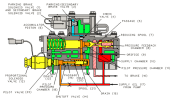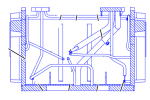Nige
Senior Member
The glib answer is that if you have to ask that question there is a possibility that you could be in over your head.What is a blanking plate? How do you go about closing off the oil supply?
Blanking plates are often used in diagnosis of leaks in systems containing oil under pressure to temporarily close off a part or parts of the system in order to help identify where it is leaking.
Generally blanking plates have to be manufactured because usually they do not figure in most manufacturer's service manuals.
This indicates that pressure is being lost in the high-pressure circuit to release the parking brake.Yes, Cat man tested the pressure. It was around 380 and fell to 40 when we cycled the parking brake.
Right now I can think of four possibilities: -
1. The service brake side of the brake control valve permanently dumping to tank.
2. LH brake piston seal failure.
3. RH brake piston seal failure.
4. A crack in one of the steel tubes that are inside the rear case that carry oil from the parking brake valve to the brake assemblies on the LH & RH sides of the machine. This is an uncommon failure but it does crop up from time to time.



